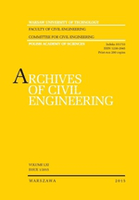
Archives of Civil Engineering
Scope & Guideline
Innovating Structural Solutions for Tomorrow
Introduction
Aims and Scopes
- Structural Engineering:
Research and development of new materials, methods, and technologies for the design, analysis, and construction of structures, including bridges, buildings, and other civil engineering infrastructures. - Geotechnical Engineering:
Studies focusing on soil mechanics, foundation engineering, slope stability, and the behavior of earth materials under various conditions. - Transportation Engineering:
Innovations in the design and operation of transportation systems, including roadways, railways, and traffic management, aimed at improving safety and efficiency. - Environmental Engineering:
Research aimed at addressing environmental challenges related to construction, including waste management, pollution control, and sustainable practices in civil engineering. - Construction Management and Technology:
Focus on project management techniques, risk assessment, cost estimation, and the use of technology in optimizing construction processes. - Materials Science in Civil Engineering:
Investigation into the properties, performance, and sustainability of construction materials, including concrete, steel, and recycled materials. - Hydraulic and Water Resources Engineering:
Studies on the management and design of hydraulic structures, flood risk management, and the impact of water resources on civil engineering projects. - Smart Infrastructure and Digital Tools:
Integration of digital technologies, such as Building Information Modeling (BIM), IoT, and AI, to enhance the design, construction, and maintenance of civil engineering projects.
Trending and Emerging
- Sustainable Construction Practices:
Growing emphasis on research that promotes environmentally friendly materials and methods, reflecting the industry's shift towards sustainability and reducing carbon footprints. - Digital Transformation in Civil Engineering:
Increased publications on the use of digital technologies, such as BIM, AI, and IoT, to improve project management, design processes, and infrastructure monitoring. - Resilience Engineering:
Research focusing on enhancing the resilience of infrastructure against natural disasters and climate change impacts has become more prominent. - Advanced Materials and Nanotechnology:
Emerging studies on innovative materials, including nanomaterials and recycled products, aimed at improving performance and sustainability in construction. - Smart Infrastructure Systems:
Growing interest in developing smart cities and infrastructure, utilizing sensors and data analytics to optimize performance and maintenance. - Health and Safety in Construction:
Increased focus on improving safety standards and practices in construction, driven by the need for enhanced worker protection and accident prevention. - Urban Planning and Development:
Research addressing the challenges of urbanization, including sustainability in urban design, infrastructure development, and community resilience.
Declining or Waning
- Traditional Construction Techniques:
Research focused on conventional construction methods has decreased as the industry shifts toward innovative materials and techniques that enhance efficiency and sustainability. - Basic Theoretical Analyses:
Papers centered on fundamental theoretical studies without practical applications are less frequently published, indicating a preference for research that addresses real-world challenges. - Non-digital Project Management:
The focus on traditional project management methods and techniques is waning as digital tools and methodologies gain prominence in the field. - Manual Soil Testing Methods:
Research employing traditional soil testing methods is decreasing as advanced technologies and automated systems become more prevalent in geotechnical investigations. - Low-tech Environmental Solutions:
There is a decline in studies proposing basic environmental solutions, as the focus shifts toward more sophisticated, technology-driven approaches to sustainability in construction.
Similar Journals
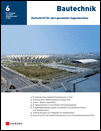
Bautechnik
Innovating the foundations of civil and structural engineering.Bautechnik is a premier academic journal in the fields of Building and Construction and Civil and Structural Engineering, published by ERNST & SOHN in Germany. With a history dating back to 1969 and a significant converged timeline through various years, this journal offers a rich repository of peer-reviewed research dedicated to advancing the principles, methodologies, and innovations within its domains. Bautechnik is currently ranked in the Q3 category for both building and construction, as well as civil and structural engineering, indicating its relevance and contribution to the academic community. Though it does not offer open access, its curated content is accessible to a global audience of researchers, professionals, and students striving for excellence in their fields. The journal aims to foster discussions and disseminate knowledge that impacts the future of construction, architecture, and engineering practices.

Transportation Infrastructure Geotechnology
Exploring the Nexus of Geotechnology and Civil Engineering.Transportation Infrastructure Geotechnology, an esteemed journal published by SpringerNature, serves as a vital platform in the fields of Civil and Structural Engineering, Environmental Engineering, Geotechnical Engineering, and Transportation. Established in 2014 and spanning a decade of significant scientific discourse, this journal has gained recognition for its robust contribution to the understanding of the interplay between geotechnical processes and transportation infrastructure. With an impactful Q2 ranking in multiple categories—including Civil and Structural Engineering and Environmental Engineering—it emphasizes innovative research and practical applications globally. Researchers and professionals can explore critical topics that influence infrastructure sustainability, safety, and efficiency. Although it operates under a subscription model, its affiliation with SpringerNature ensures rigorous peer-review and high-quality publications, making it an indispensable resource for academics and industry experts alike.

Revista Ingenieria de Construccion
Advancing the Frontiers of Construction EngineeringRevista Ingenieria de Construccion is a prominent open-access journal dedicated to advancing knowledge and practice in the fields of building and construction engineering, as well as civil and structural engineering. Published by the Pontificia Universidad Católica de Chile, specifically the Department of Engineering and Construction Management, this journal has been providing free access to quality research outputs since 1986, ensuring that vital information is available to both practitioners and academics globally. With its current placement in the Q4 category of both the Building and Construction and Civil and Structural Engineering quartiles, it serves as a platform for innovative studies and critical discussions, positioning itself strategically within the academic landscape. The journal is indexed in Scopus, ranking #157 in Building and Construction and #291 in Civil and Structural Engineering, reflecting the growing impact and relevance of its contributions. Researchers, professionals, and students are encouraged to engage with the rigorous and diverse content published within its pages, fostering a vibrant academic and practical discourse.
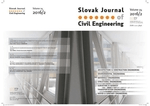
Slovak Journal of Civil Engineering
Innovating infrastructure: Bridging theory and practice.Welcome to the Slovak Journal of Civil Engineering, a premier open-access publication dedicated to advancing the field of civil engineering. Published by SCIENDO, this journal has been providing a platform for the dissemination of groundbreaking research since 2010, ensuring that all articles are freely accessible to a global audience. With a commitment to promoting innovation and excellence within civil engineering, the journal covers a wide range of topics, including structural engineering, transportation systems, geotechnics, and environmental engineering. The Slovak Journal of Civil Engineering is designed to engage a diverse community of researchers, professionals, and students, fostering collaboration and knowledge-sharing to address contemporary challenges in the field. With its open-access model, the journal not only enhances visibility for authors but also ensures that the latest findings and methodologies reach practitioners and academics alike, making it an essential resource for anyone interested in civil engineering advancements. Stay connected with the evolving landscape of civil engineering through this influential publication.

Turkish Journal of Civil Engineering
Innovating Construction Through ResearchWelcome to the Turkish Journal of Civil Engineering, a pioneering publication under the auspices of the TURKISH CHAMBER OF CIVIL ENGINEERS, dedicated to advancing the field of civil engineering and construction. With a focus on cutting-edge research and innovative practices, this journal seeks to provide a platform for scholars, professionals, and students to share their findings and insights within the sphere of civil and structural engineering. The journal is committed to open access, ensuring that research is readily available to a global audience. As it embarks on its journey from 2023 to 2024, it aims to enhance its reputation as a vital resource within the academic community, currently ranking in the 40th percentile for Building and Construction Engineering and 32nd for Civil and Structural Engineering in Scopus. We encourage contributions that push the boundaries of engineering knowledge, fostering collaboration and progress in this essential field.

Teknik Dergi
Cultivating a Legacy of Civil Engineering ResearchTeknik Dergi is a key academic journal published by the Turkish Chamber of Civil Engineers, focusing on the critical fields of Building and Construction as well as Civil and Structural Engineering. Established in Turkey, this journal serves as a vital platform for researchers, practitioners, and students to disseminate innovative findings and advancements within these disciplines. Although its coverage in databases like Scopus has been discontinued since 2022, Teknik Dergi remains a respected resource for its historical contributions, with a record of publication spanning from 1990 to 1998 and then from 2002 to 2022. The journal currently holds a Q4 categorization in both its primary fields, ranking within the 30th and 25th percentiles respectively. Authors and readers can access articles exploring practical applications and theoretical foundations, making it a valuable asset for those engaged in the rapidly evolving landscape of civil engineering. Open Access options are also available, allowing for broader dissemination and engagement with its published work.
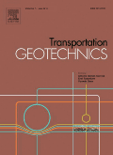
Transportation Geotechnics
Bridging the Gap Between Geotechnics and Mobility.Transportation Geotechnics is a premier academic journal published by Elsevier, focusing on the intersection of geotechnical engineering and transportation systems. With an impressive impact factor and categorized in the Q1 quartile across multiple disciplines including Civil and Structural Engineering, Geotechnical Engineering, and Transportation, this journal stands as a vital resource for researchers and practitioners alike. It covers a broad spectrum of topics ranging from soil behavior in transport contexts to innovative materials and methods that enhance infrastructure stability and performance. As an essential platform fostering knowledge dissemination, Transportation Geotechnics enables contributors to share their groundbreaking findings while providing readers with access to cutting-edge research and reviews from 2014 to 2024. Its illustrious Scopus rankings place it prominently in the global research landscape, making it an indispensable tool for students, professionals, and academics dedicated to advancing the field.
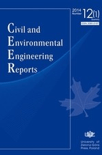
Civil and Environmental Engineering Reports
Unlocking insights for a greener tomorrow in engineering.Civil and Environmental Engineering Reports is a prestigious open access journal published by UNIV ZIELONA GORA, dedicated to advancing research in the dynamic fields of civil and environmental engineering. With its ISSN 2080-5187 and E-ISSN 2450-8594, the journal aims to disseminate innovative studies, methodologies, and practical applications that address contemporary challenges in these disciplines. Since its establishment in 2014 as an open access platform, it has emerged as a vital resource for researchers, professionals, and students alike, enabling free access to high-quality research findings. Situated at Licealna 9, Zielona Góra 65-417, Poland, the journal strives to foster collaboration and knowledge exchange within the global engineering community, making it an essential reading for anyone invested in civil and environmental engineering advancements.

Baltic Journal of Road and Bridge Engineering
Pioneering Research in Road and Bridge EngineeringThe Baltic Journal of Road and Bridge Engineering, published by RIGA TECHNICAL UNIV-RTU, serves as a pivotal platform for disseminating cutting-edge research in the fields of building and construction as well as civil and structural engineering. Established as an Open Access journal since 2006, it fosters global collaboration and accessibility to critical engineering knowledge, facilitating the exchange of innovative ideas among researchers, professionals, and students. With a commendable impact factor and recognition in Scopus rankings, where it stands in the third quartile for both relevant engineering categories, the journal underscores its significance in advancing the discipline. The journal aims to publish high-quality, peer-reviewed articles that address contemporary challenges in road and bridge engineering, making it an essential resource for anyone involved in infrastructure development and research. Located in Lithuania at 6B Kipsalas Street, RIGA LV-1658, this journal not only highlights the latest advancements but also seeks to inspire future innovations in engineering practices.

CANADIAN JOURNAL OF CIVIL ENGINEERING
Advancing Civil Engineering Knowledge Since 1971Canadian Journal of Civil Engineering, published by Canadian Science Publishing, serves as a premier platform for the dissemination of innovative research and development in the fields of civil and structural engineering, as well as environmental science. Established in 1971, this journal maintains a robust reputation, achieving a Q3 ranking in both civil engineering and general environmental science categories as of 2023. While it does not currently offer open access, the journal is accessible to a wide audience of researchers, professionals, and students who are keen to stay abreast of the latest advancements in civil engineering practices. With a significant number of yearly publications and a committed editorial board, the Canadian Journal of Civil Engineering contributes to the foundational knowledge and practical applications in the engineering community, thereby playing a critical role in addressing contemporary challenges in civil infrastructure and environmental sustainability.